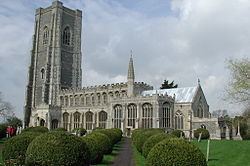Spouse Anna King (m. 1493) Died 1523 | Name Thomas of | |
 | ||
Parent(s) Thomas Spring, Margaret Appleton Children John Spring of Lavenham, Rose Spring, Bridget Spring, Annie Spring, Robert Spring Grandchildren William Spring of Lavenham People also search for John Spring of Lavenham | ||
Thomas Spring (c. 1474 – 1523), also referred to as Thomas Spring III or The Rich Clothier, was an English cloth merchant during the early 1500s. From Lavenham in Suffolk he consolidated his father's business to become one of the most successful in the booming wool trade, and was one of the richest men in England in his lifetime.
Contents

Family
The Spring family was descended from the Anglo-Norman knight, Sir Henry Spring, and Thomas Spring was the great-grandson of Lord Jermyn of Rushbrooke Hall.
Thomas Spring was the eldest son and heir of Thomas Spring (d. 7 September 1486) of Lavenham, Suffolk, and Margaret Appleton. His father's will mentions Thomas and two other sons, William and James (slain 1493), as well as a daughter, Marian. He had another brother, John Spring, whose daughter, Margaret, married Aubrey de Vere, second son of John de Vere, 15th Earl of Oxford; Aubrey de Vere and Margaret Spring were the grandparents of Robert de Vere, 19th Earl of Oxford.
The will of Thomas Spring's grandfather, also named Thomas (d.1440), mentions his wife, Agnes, his eldest son and heir, Thomas (d. 7 September 1486), another son, William, and two daughters, Katherine and Dionyse.
Career
Thomas inherited the Spring family wool and cloth business from his father, and during his lifetime the cloth trade was at its most profitable. By the time of his death, Spring was believed to be the richest man in England outside the peerage, having invested much of his money in land.
In 1512, 1513 and 1517 his name appears as one of the commissioners for collecting taxation in Suffolk. Spring played a large part in defeating supporters of William de la Pole, 1st Duke of Suffolk, who claimed the throne from Henry VII. However, in 1517, in the reign of Henry VIII, Spring was given exemption from his public duties. At this point, he was probably at the height of his wealth.
Spring is mentioned in John Skelton's satirical poem Why come ye not to Court, which makes reference to the rich clothier with whom Skelton is said to have been friends. He writes:
"Now nothing, but pay pay with laughe and lay downe Borough, Citie and towne good Springe of Lanam must count what became of his clothe makyng. My Lordes grace will bryng down thys hye Springe and brynge it so lowe it shal not ever flow."
Like his father, Thomas Spring was closely involved in the rebuilding of St Peter and St Paul's Church in Lavenham. This was partly done in order to propitiate the 13th Earl of Oxford, who had ordered the reconstruction work and was the church's other principal donor. The rebuilding also gave Spring an opportunity to display his wealth and generosity, thus solidifying his position in Suffolk; a common motivation behind the construction of many wool churches.
Spring made his last will on 13 June 1523 as 'Thomas Spring of Lavenham, clothmaker', leaving his wife, Alice, all her apparel and jewels, 1000 marks in money, and half his plate and implements of household, with the other half to go to his eldest son and heir, John. Spring also left bequests to his son, Robert, his unmarried daughter, Bridget, the children of his married daughter, Rose Guybon, and the children of his son-in-law, Thomas Jermyn. To 'my wife's daughter, Alice May', he bequeathed £26 13s 4d, 'which I recovered for her of May's executors', to be paid to her at the age of sixteen.
Thomas Spring was buried in the Spring family parclose in Lavenham church before the altar of St Katherine. His widow commissioned Flemish wood carvers to create a ten-foot high parclose screen around his tomb, which is one of the most intricate of its type still in existence.
Marriage and issue
Thomas Spring is said to have married firstly, in 1493, Anne King, whose family was of Boxford, Suffolk, by whom he had two sons and two daughters:
Spring married secondly a wife named Alice (d.1538), the widow of a husband surnamed May, by whom he had a daughter:
Spring's widow, Alice, survived him by fifteen years. In her will, dated 13 April 1538, she mentions her daughter by Thomas Spring, Bridget, now the wife of William Erneley; her daughter Alice, now the wife of Richard Fulmerston, gentleman; and her daughter Margaret (died c. 1552), the wife of William Risby (died c. 1551). She appoints as executors her daughter Margaret and sons-in-law, William Risby and Richard Fulmerston, and requests "my Lord of Oxenford to aid and defend my said executors." In a codicil added 31 August 1538, she discharges Richard Fulmerston as executor, and appoints him supervisor. Both will and codicil were proved 5 September 1538.
